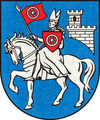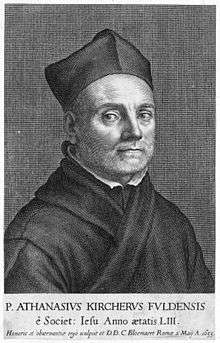Heilbad Heiligenstadt
Heilbad Heiligenstadt is a spa town in Thuringia, Germany. It is the capital of the Eichsfeld district.
Heilbad Heiligenstadt | |
|---|---|
 Saint Mary's Church, 14th century | |
 Coat of arms | |
Location of Heilbad Heiligenstadt within Eichsfeld district  | |
 Heilbad Heiligenstadt  Heilbad Heiligenstadt | |
| Coordinates: 51°22′44″N 10°08′19″E | |
| Country | Germany |
| State | Thuringia |
| District | Eichsfeld |
| Government | |
| • Mayor | Thomas Spielmann (BI Menschen für Heiligenstadt) |
| Area | |
| • Total | 70.88 km2 (27.37 sq mi) |
| Elevation | 255 m (837 ft) |
| Population (2018-12-31)[1] | |
| • Total | 17,105 |
| • Density | 240/km2 (630/sq mi) |
| Time zone | CET/CEST (UTC+1/+2) |
| Postal codes | 37308 |
| Dialling codes | 03606 |
| Vehicle registration | EIC, HIG, WBS |
| Website | www.heilbad-heiligenstadt.de |
Geography
Heiligenstadt is approximately 14 km east of the tripoint where the states of Thuringia, Hesse and Lower Saxony meet. An upper reach of the River Leine, a tributary of the Aller, flows through the town from east to west and is joined near the centre of the town by the River Geislede.
South of the town is the Iberg, a 453.2 m tall peak located in the Heiligenstadt Stadtwald, which forms part of the Naturpark Eichsfeld-Hainich-Werratal.
Local subdivisions
- Bernterode
- Flinsberg, the geographical centre of Germany.
- Günterode
- Kalteneber
- Rengelrode
History
- Heiligenstadt was first mentioned in 973.
- In 1022 it was acquired by the archbishop of Mainz.[2]
- In 1227, the town received town rights from the archbishop of Mainz.
- In 1333 it was destroyed by fire.[2]
- In 1525 it was captured by Henry the Middle, Duke of Brunswick-Lüneburg.[2]
- In 1540 Heiligenstadt became the capital of Eichsfeld.
- In the Thirty Years' War of 1618–1648, the city was devastated several times.
- In 1803 it came into possession of Prussia.[2]
- In 1929 the salt-water hydropathic baths were built and in 1950 the town was designated a spa.
- On 9 November 1938, the town synagogue was desecrated. The event is commemorated in a plaque on the building, which is now a residence.
- In October 1989, demonstrations began in Heiligenstadt as part of the Peaceful Revolution in East Germany.
- In 1994, Heiligenstadt became the capital of the new district of Eichsfeld, formed by the amalgamation of the districts of Heiligenstadt and Worbis.
Historical Population
Population (31 December):
|
|
|
|
|
|
- Data since 1994: Thüringian state office of statistics
Name of the town
Despite the official designation of the town as a spa in 1929 and a 1950 decision by the town council to append the word Soleheilbad (salt-water spa) to its name, it remained officially "Heiligenstadt" during the East German years. In 1990 the city government still used only Heiligenstadt.
However, the post office used Heilbad Heiligenstadt, as did postcard companies and the local savings bank. In fact between 1950 and 1990, the town had the distinction of being referred to in three different ways: as Heiligenstadt, Heilbad Heiligenstadt, or Heiligenstadt (Eichsf.) (for Eichsfeld).
In 1990, the town council and especially the mayor began expanding the spa business and it took on increasing importance. In addition, after German reunification, there were several Heiligenstadts in Germany. Initially the government declined to rename the town Heilbad Heiligenstadt because of a lack of evidence that it was a spa, but the town lodged an appeal and used the one and a half years before an official visit and the relative lack of oversight immediately after reunification to create spa facilities and integrate the word Heilbad into official usage. Permission for the renaming was then granted since the town was evidently a spa and using that name.

Culture and sights
Theatre
- Eichsfeld Kulturhaus
Museums
- Theodor Storm Literary Museum
- Eichsfeld Heimatmuseum (local history collection)
- Heiligenstadt (Ost) Station Museum
Buildings and monuments
- Mainz Schloss, seat of the administrator for Eichsfeld when it was a dominion of the Archbishopric of Mainz
- Klausmühle (1748 Fachwerk mill on the site of the birthplace of Tilman Riemenschneider)
- Einheitsdenkmal German Unity Monument in front of the town administration building, 2009
Churches and chapels
- St. Aegidius, also known as the Neustädter Kirche (new-town church): begun in the 13th century
- St. Mary's, also known as the Altstädter Kirche (old-town church), Liebfrauenkirche (Our Lady's) and Propsteikirche (abbey church): a 14th-century monastic foundation which replaced a 13th-century Romanesque building
- St. Anne's chapel, possibly built as an ossuary, facing the north portico of St. Mary's
- St. Martin's, also known as the Bergkirche (mountain church)[3]
- Monastery of the Congregation of the Most Holy Redeemer and St. Gerhard's church, also known as the Paterkloster
- St. Nicholas', also known as the Klausbergkirche
- Klöppelsklus
- Convent of the Sisters of Mary Magdalene Postel, with convent church and school church
Cemeteries
- The Jewish cemetery in Ibergstraße was last used for burial in 1940. The deportation of six Jewish residents to Theresienstadt concentration camp in September 1942 put an end to a Jewish community in the town which was first mentioned in writing in 1212 and which had built a synagogue and their own school in the 19th century.
- The Soviet cemetery and monument in Dingelstädter Straße commemorate 70 Soviet prisoners of war and impressed workers who died in the town due to forced labour during World War II.
Parks
- Heinrich Heine Kurpark (spa park)
Regular events
Heiligenstadt, like the rest of Eichsfeld, is traditionally Roman Catholic, so there are several annual religious events, in particular the procession through the old town on Palm Sunday with life-size figures from the Passion of Christ, which attracts numerous believers from the region and the rest of Germany.
Ibergrennen
The Ibergrennen is an annual road race held since 1994 on the last weekend in June on Landesstraße 2022 (Holzweg) in the western foothills of the Iberg. Sponsored by the German Mountain Cup and German Mountain Championship, it has included sports and touring cars since 1998, when the road surface was renewed and the barriers reinforced. In 2000, the course was extended from 1.96 km to 2.05 km. The climb remains 200 m. It is thus one of the shortest mountain race routes in Germany, but not without challenges.
The drivers' encampment is traditionally set up near the centre of Heiligenstadt, next to a filling station and a supermarket which is open on Sundays.
The first race was held in 1925, but only for motorcycles.

People associated with Heilbad Heiligenstadt
Honorary citizens
- Johann Vinzenz Wolf (1743–1826), Jesuit historian[4]
- 1855: Josef Nolte (1781–1863), Archiepiscopal representative
- 1991: Hugo Dornhofer, Christian labour union official and CDU politician
- 2004: Paul J. Kockelmann, local administrator 1967–1995
Natives

- Tilman Riemenschneider (c. 1460–1531), sculptor
- Johann Melchior Birkenstock (1738–1809), Austrian politician and school reformer
- Josepha von Siebold (1771–1849), gynaecologist, the first credentialled midwife in Germany.
- Adolf Werneburg (1813–1886), genealogist and forester
- Eduard Strecker (1822–1894), politician
- Ludwig Loewe (1837–1886), politician
- Helene Keßler (1870–1957), writer, under the pseudonym Hans von Kahlenberg
- Siegfried Loewenthal (1874–1951), chief justice in West Berlin 1945–1951, honorary citizen of Heiligenstadt 1948–1951
- Alfred Mock (1908–2006), Catholic priest
- Horst Sannemüller (1918–2001), violinist and leader of the Leipzig Gewandhaus Orchestra
- Wilhelm Friese (1924–2008), professor of Scandinavian studies
- Karl H. Steinberg (born 1941), politician
- Wolfgang Thüne (born 1949), Olympic medallist in gymnastics
- Joachim Knape (born 1950), professor of rhetoric
- Bernhard Germeshausen (born 1951), Olympic medallist in bobsleigh
- Dietrich Klinge (born 1954), sculptor and graphic designer
- Angelika Weiz (born 1954), singer
- Dieter Althaus (born 1958), politician (CDU) Ministerpresident of Thuringia 2003–09
- Peter Pysall (born 1960), handball player and coach
- Sebastian Haupt (born 1985), skeleton racer
Others


- Saint Aureus of Mainz (5th century), Bishop of Mainz: some of his remains were reinterred in Heiligenstadt and he is the patron saint of the town.
- Burchard of Worms (c. 965–20 August 1025), consecrated Bishop of Worms in Heiligenstadt in 1000.
- Adolf I of Nassau (1353–1390), Archbishop of Mainz, died in Heiligenstadt.
- Athanasius Kircher (1602–1680), Jesuit scholar, taught in Heiligenstadt.
- Hadrian Daude (1704–1755), Jesuit theologian, taught in Heiligenstadt.
- Friedrich Christian Adolf von Motz (1775–1830), Prussian statesman, was Director of Finance in Heiligenstadt.
- Heinrich Heine (1797–1856), poet and journalist, was baptised a Protestant in Heiligenstadt in June 1825.
- Johann Carl Fuhlrott (1803–1877), natural historian, taught in Heiligenstadt.
- Heinrich Maria Waldmann (1811–1896), theologian and teacher in Heiligenstadt, a representative in the Frankfurt Parliament of 1848/49.
- Theodor Storm (1817–1888), author, judge in Heiligenstadt from 1856 to 1864.
- Friedrich Wilhelm Grimme (1827–1887), author and botanist, was director of the Catholic gymnasium in Heiligenstadt.
- Werner Hagedorn (1831–1894), surgeon, educated in Heiligenstadt.
- Anton Thraen (1843–1902), astronomer, educated in Heiligenstadt.
- Karl Wisniewski (1844–1904), composer, worked in Heiligenstadt from 1885 on.
- Hermann Iseke (1856–1907), poet
- Martin Weinrich (1865–1925), Catholic educator and author, educated in Heiligenstadt.
- Andreas Huke (1876–1962), politician, worked and lived in Heiligenstadt.
- Walter Möllenberg (1879–1951), historian, died in Heiligenstadt
- Ludolf Hermann Müller (1882–1959), Protestant Bishop of Saxony, had been a minister in Heiligenstadt.
- Karl Paul Haendly (1891–1965), author and politician, died in Heiligenstadt.
- Karl Hackethal (1901–1990), politician, educated in Heiligenstadt.
- Herbert Haselwander (1910–1940), Nazi district leader in Heiligenstadt.
- Erich Gerberding (1921–1986), actor, member of the Heiligenstadt theatre.
- Horst Keitel (born 1928), actor, member of the Heiligenstadt theatre from 1946 to 1951.
- Rudolf Richwien (born 1928), neurologist, retired to Heiligenstadt.
- Johannes Dyba (1929–2000), Bishop of Fulda, educated in Heiligenstadt.
- Joachim Meisner (born 1933), Archbishop of Cologne, previously chaplain at St. Egidius' church in Heiligenstadt.
- Georg Sterzinsky (born 1936), Archbishop of Berlin, previously chaplain at St. Egidius' church in Heiligenstadt.
- Heinz-Josef Durstewitz (born 1945), Catholic dissenter in the GDR, now Provost of Heiligenstadt.
- Reinhard Hauke (born 1953), Auxiliary bishop of Erfurt, previously chaplain at St. Egidius' church in Heiligenstadt.
- Manfred Grund (born 1955), politician, active in Heiligenstadt.
References
- "Bevölkerung der Gemeinden, erfüllenden Gemeinden und Verwaltungsgemeinschaften nach Geschlecht in Thüringen Gebietsstand: 31.12.2018". Thüringer Landesamt für Statistik (in German). September 2019.
- Chisholm, Hugh, ed. (1911). . Encyclopædia Britannica. 13 (11th ed.). Cambridge University Press. p. 212.
- Thomas T. Müller, ed., Die St.-Martins-Kirche zu Heiligenstadt, Heiligenstädter Schriften 2, Heiligenstadt 2003 (in German)
- H. Scholle, Ein Denkmal für den Ehrenbürger der Stadt Heiligenstadt Johann Wolf in Kreuzebra, Eichsfeld 9, Heimat- und Verkehrsverband Eichsfeld e.V, 1997 (in German)
Sources
- Johann Vinzenz Wolf. Geschichte und Beschreibung der Stadt Heiligenstadt mit Urkunden. Göttingen: Beyersche Universitätsdruckerei, 1800. At Google Books
- Hans Patze (Ed.) "Heiligenstadt". In: Thüringen: Handbuch der historischen Stätten Deutschlands, Volume 9. Stuttgart: Alfred-Kröner-Verlag, 1989. ISBN 3-520-31302-2. pp. 186–190.
- Carl Duval. "Heiligenstadt". In: Das Eichsfeld. Repr. Hannover-Dören: Harro von Hirschheydt Verlag, 1979. ISBN 3-7777-0002-9. pp. 422–489.
- Karl J. Hüther. Vom Jesuitenkolleg zum Staatlichen Gymnasium in Heiligenstadt. Heiligenstadt: F.W. Cordier,1995. ISBN 3-929413-25-6.
- Enno Bünz. "Heiligenstadt als geistliches Zentrum des Eichsfeldes. Das Kollegiatstift St. Martin und seine Kanoniker". Zeitschrift des Vereins für Thüringische Geschichte 62 (2008) 9-48.
- Bernhard Opfermann. Gestalten des Eichsfeldes: Ein biographisches Lexikon. Heiligenstadt: Cordier, 1999, ISBN 3-929413-37-X.
External links
| Wikimedia Commons has media related to Heilbad Heiligenstadt. |
- www.heilbad-heiligenstadt.de - official homepage of Heilbad Heiligenstadt